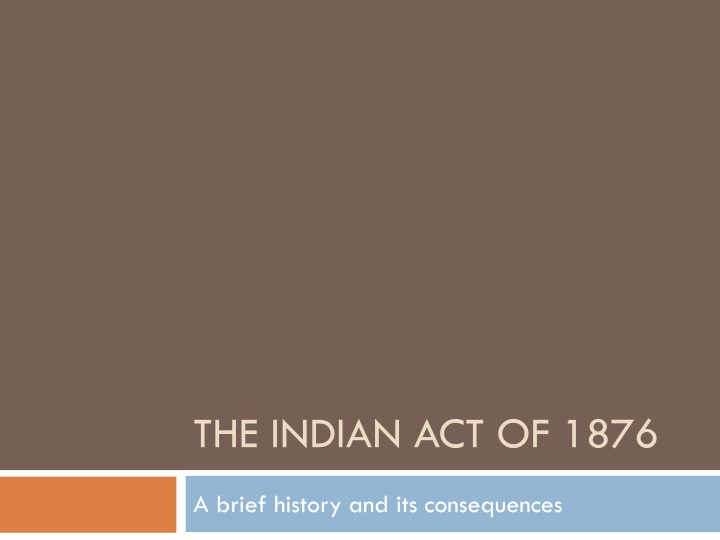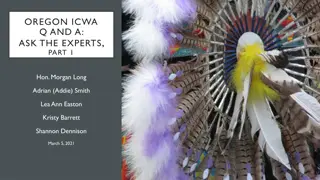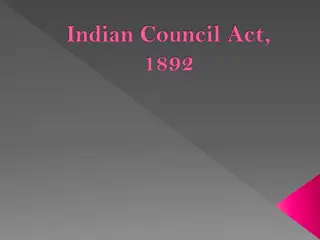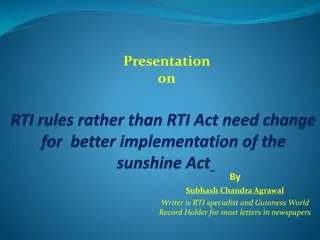
Impact of the Indian Act of 1876 on Aboriginal Communities
Explore the historical context and consequences of the Indian Act of 1876 in Canada, highlighting its assimilation goals, impact on Aboriginal rights, and the evolution of government policies towards Indigenous peoples. Learn about key events such as the Royal Proclamation of 1763, the Gradual Civilization Act of 1857, and the shifting responsibilities post-Confederation of 1867. Understand the ideologies shaping the Department of Indian Affairs and its role in assimilating Indigenous populations into mainstream society.
Download Presentation

Please find below an Image/Link to download the presentation.
The content on the website is provided AS IS for your information and personal use only. It may not be sold, licensed, or shared on other websites without obtaining consent from the author. If you encounter any issues during the download, it is possible that the publisher has removed the file from their server.
You are allowed to download the files provided on this website for personal or commercial use, subject to the condition that they are used lawfully. All files are the property of their respective owners.
The content on the website is provided AS IS for your information and personal use only. It may not be sold, licensed, or shared on other websites without obtaining consent from the author.
E N D
Presentation Transcript
THE INDIAN ACT OF 1876 A brief history and its consequences
In the beginning The Royal Proclamation 1763 Acknowledged Aboriginal sovereignty and land title Lands would have to be negotiated and purchased: rights would be defined and protected
Changing Government Ideas Gradual Civilization Act 1857 All male Indians and M tis over 21 yrs of age had to read, write, speak English or French, be a good citizen and choose an approved surname. They would be enfranchised : giving up Indian rights for citizenship. They would be British subjects but with far fewer rights. Loss of Indian status and identity, land claims, ability to live on reserve
One Nation United from Sea to Sea Confederation 1867 Responsibility of First nations transferred from Great Britain to the Canadian Government Gov t was now responsible for protecting the rights of the Aboriginal people Major questions: How to settle the west? Building the CPR Expanding the country
Indian Act of 1876 A consolidation of all the aboriginal laws Main goal: assimilation! = eliminate the Indian Problem Gov t working under the idea that they had to look out for Aboriginals best interest (protecting them from whiskey traders and Americans) The Indian Act allowed the Canadian gov t to extinguish Aboriginal rights and title to land completely and created treaties that granted back certain specific rights.
The Department of Indian Affairs Dr. Duncan Campbell Scott -1920 Department of Indian Affairs 1913-1932 I want to get rid of the Indian problem. I do no think as a matter of fact, that the country ought to continuously protect a class of people who are able to stand alone Our objective is to continue until there is not a single Indian in Canada that has not been absorbed into the body politic and there is no Indian question, and no Indian Department
What is an Indian? The Indian Act of 1876 defined Indian as: Any male person of Indian blood that belongs to a particular band Any child of such person Any woman who is or was lawfully married to such person.
The Loss of Aboriginal Rights Defined who was Indian (identity was a number) No self government (end of hereditary chiefs) Not allowed to vote (unless gave up status) Prohibited from buying or consuming alcohol Couldn t leave the reserve without the Indian Agent s permission Limited economic activities on the reserve or sell products off the reserve Forbidden from holding traditional ceremonies (i.e. potlatch, Sun Dance) Educated at government run schools (residential schools)
Numbered Treaties 11 treaties were signed between 1871 and 1929 Why did Aboriginals sign these treaties? Didn t believe they were giving up their claim to the land they were negotiating its use Believed they were protecting their people and rights In some cases, their way of life was collapsing and needed a new means of livelihood
What is a reserve? Have you seen a reserve? What does it look like?
Government creates reserves Aboriginals were placed on reserves Gov t decided the location and size of reserves If there was any negotiation, it wasn t a fair and equal process Given poor land to settle upon Not allowed to leave unless they had permission from an Indian Agent Couldn t sell farming produce without permission Houses would be built and owned by the Cdn gov t Families were given a certain amount of land
The Loss of the Potlatch An important cultural and spiritual practice among native groups on the Pacific Northwest coast. Chiefs used them to name children, announce marriages, transfer titles and mourn death. Chiefs and their family increased honor and status by giving guests gifts and reciting family history. Also, an economic function of redistributing wealth. In 1884, spend 6 months in jail if hosted a potlatch. Real pressure in 1920s, forced to surrender sacred objects and also arrest participants. Ban was not lifted till 1951.
Who you married mattered Historically, many First Nations groups were matrilineal (Fancy word = your mother s side). An Aboriginal Woman could lose her status in the following ways marrying a man who was not a status Indian Enfranchisement (until 1960, an Indian could vote in federal elections only by renouncing Indian status) having at the age of 21 a mother and paternal grandmother who did not have status before marriage being born out of wedlock to a mother with status and a father without.
What it feels like for a girl The Indian Act had devastating consequences for First Nations women. A disenfranchised Indian woman was prohibited from: residing on their reserve inheriting family property receiving treaty benefits participating in band councils and other affairs of the Indian community Being buried in cemeteries with their ancestors ** Between 1958-1968, approx. 4,605 First Nations women lost their status by marrying white men**
Sandra Lovelace: A successful appeal a Maliseet woman, Tobique Reserve in New Brunswick Married a non native man in 1970, moved to California Divorced, attempted to move back home , lost status, her and her children had no rights to education, housing and health care. Took it to United Nations, allowed Canadian Gov t to defend themselves. Ruled in favor of Lovelace, but slow to make changes. (male dominance of certain native bands) 1985 Sandra Lovelace, thanks to her successful appeal to the Human Rights Committee of the United Nations, Native women in Canada no longer lose their status under the Indian Act through marriage to a non-native man Started her appeal, took her ten years to regain status Now a member of the Senate for New Brunswick representing the Liberal party.
Time for a change: Bill C-31 An Act to Amend the Indian Act It ends discriminatory provisions of the Indian Act, especially those that discriminated against women. A woman who marries a member of another band no longer automatically becomes a member of her husband's band. It changes the meaning of "status" and for the first time allows for limited reinstatement of Natives who were denied or lost status in the past. It allows bands to define their own membership rules. 2011 re-registering grandchildren of women that lost their status for marrying non-Native men. (A supreme court action)
Misconceptions and Myths Myth #1: Natives do not pay taxes
Answer? It depends. The Indian Act does contain certain tax exemptions for those with status but it is a misconception that they do not pay taxes at all. **when off reserve lands, general Canadian taxation applies** This does not apply to the M tis and the Inuit
Misconceptions and Myths cont. Myth #2: Aboriginals get free post- secondary education
Answer? It depends. This is how it works: Ottawa provides education money to Indian bands, which in turn decide whose education to finance. Because there is only so much money for post-secondary education, some bands may decide to fund only those pursuing their first degree, or perhaps only those living on the reserve. Inuit and M tis are exempted from the free post-secondary education that some Status Indians receive.
Indian Act in the News: A University of Manitoba graduate student is walked across Canada to call on the federal government to make changes to the Indian Act. Baskatawang, a master's student in native studies, said he is raising awareness about federal policy and legislation that relates to Canada's aboriginal peoples. "It's important because, you know, aboriginal peoples have been oppressed. I mean, they're stigmatized in society, there's lots of stereotypes and prejudice," he said. "I think if we changed the federal policy and legislation, it would help alleviate all that. Leo Baskatawang's March 4 Justice, in which he walked from Vancouver to Ottawa with a copy of the Indian Act chained to him.
An Act to Amend the Indian Act and Provide for its Replacement Bill C-428 Rob Clarke, MP in northern Saskatchewan and a Cree from Muskeg Lake First Nation tabled Bill C-428 Main Provisions for change: The right for indigenous people to write wills and settle estates without ministerial approval. This is not what the government should be deciding, he said. The right for indigenous communities to create bylaws. The right for indigenous people to grow produce on their own land and sell it.
An Act to Amend the Indian Act and Provide for its Replacement Bill C-428 He also wants to repeal the government s rights to: Create residential schools, a dark part of history [that] I want to prevent from ever happening again." Restrict trade with other individuals on reserve, a provision that dates back to the days of government Indian agents on reserves.
Controversy Aboriginal groups are happy that there is a push for change But The change is coming from the government. Indigenous groups want changes to come from native groups and scholars. More likely to address issues of identity and citizenship, rather than economics.
THE INDIAN ACT OF 1876 CREATED BY T. FULLER Aboriginal Education Department SD#43 September 2012






















